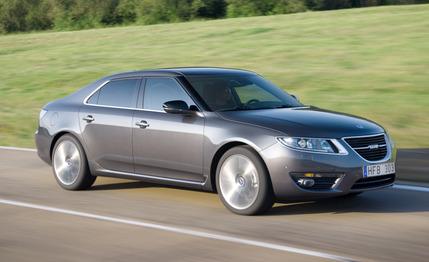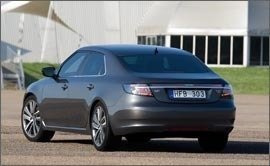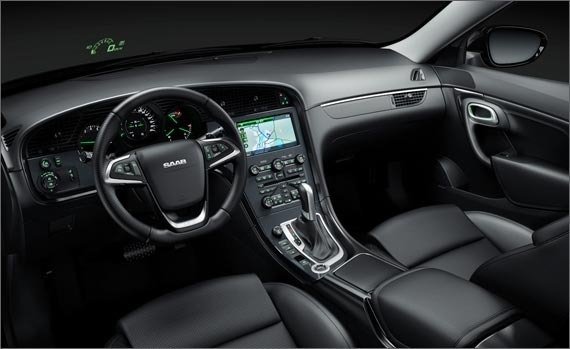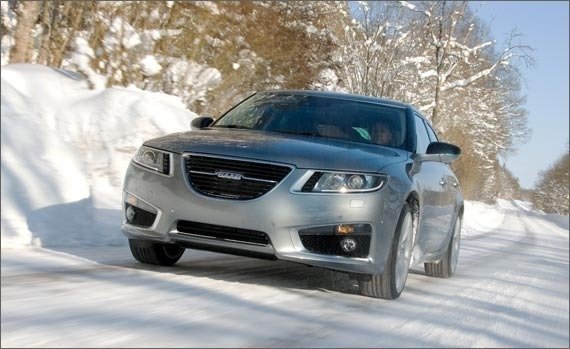
 First Drive Review
First Drive Review
Until Dutch specialty carmaker Spyker took the plunge and bought Saab from General Motors, there was a good chance this car would never have been built. True, the new 9-5 had been seen on the auto-show circuit, but had GM failed to find a buyer for Saab and completed the liquidation of the company, this sedan would have remained stillborn. That would have been a pity, because this is the best Saab for some time and, ironically, the best one developed under GM’s 20-year ownership.
The basis of the 2011 9-5 is GM’s Epsilon platform that also underpins the Buick LaCrosse. Compared with the previous-generation car, now in its 13th year, the latest 9-5 is 6.8 inches longer, at 197.2 inches overall, and 3.0 inches wider, at 73.5 inches. It rides on a 5.3-inch-longer wheelbase of 111.7 inches. Dimensionally, it’s bigger than the Audi A6, Volvo S80, and BMW 5-series.


The car will be available in the United States with two engines. At launch, we’ll see the 9-5 Aero with the turbocharged 2.8-liter V-6 that’s also fitted to the Cadillac SRX, making 300 hp and 295 lb-ft of torque. This engine drives all four wheels through a paddle-shifted six-speed automatic transmission and Saab’s XWD all-wheel-drive system. XWD uses a Haldex clutch pack with a standard rear electronic limited-slip differential. In September, Saab will offer a 2.0T model powered by a direct-injection version of the 2.0-liter four-cylinder engine that’s used in the 9-3. It will make 220 hp and 258 lb-ft of torque in this guise. The 2.0T will be available with front-wheel drive, mated to a standard six-speed manual or optional six-speed automatic transmission. All-wheel drive in the 2.0T will be available in other markets but is not yet confirmed for the U.S.
Different Models, Different Suspensions
The two models use slightly different suspensions. The Aero has GM’s so-called HiPer strut front end that essentially decouples the steering knuckle from the strut, increasing the longitudinal stiffness and reducing torque steer. The 2.0 turbo, however, has a conventional front strut layout. At the back, there’s a so-called H-arm multilink suspension that Saab says gives better ride comfort and noise, vibration, and harshness characteristics than the simpler four-link setup fitted to European-market models equipped with small-capacity diesel engines. Base Aero models have 18-inch wheels and tires, but cool 19s are available for $750.
The Aero gets electronically controlled shocks as standard with three driver-selectable modes: comfort, intelligent, and sport. (The system is optional on the 2.0T.) The comfort setting has lighter steering effort than sport, a less aggressive throttle map and shift points, and softer damping. In the intelligent setting, the damping stiffens to the same level as sport under hard cornering but reverts to the softest setting in a straight line. Really aggressive driving in the intelligent mode firms up the steering, but the shift points and the throttle map remain unchanged. In the sport mode, a driver can also mix and match settings using the onboard computer.
Retro Cues, Not Retro Design
According to chief designer Simon Padian, certain elements of the 9-5 hark back to old Saabs, but it’s not a retro design. Inspiration, he says, also comes from the Aero X concept of 2006. “The wraparound windshield, the hockey-stick rear side glass, the concave C-pillar that goes back to the 99, and the clean body side that sticks to Scandinavian design philosophy are traditional Saab cues,” he says. We like the exterior design—it’s striking and very different from its competitors in the $40,000-plus luxury-car market.
Inside, too, the 9-5 is quite simple and unadorned. Unfortunately, all the interiors on the cars we drove were dark—there is a lighter color available—giving an overwhelmingly dour ambience that’s barely leavened by a multitude of alloy accents around the doors, shift lever, and center stack. The design is very functional, however, and Saab pays homage to its past with an engine-start button that is situated behind the shift lever on the center console. Rear-seat riders will love the amount of legroom, which makes a 5-series seem positively parsimonious.


The Aero model gets plenty of standard features, including xenon headlamps, dual-zone climate control, power front seats, leather seating trim, front and rear park assist, a nine-speaker Harman/Kardon audio system, and Bluetooth hands-free phone connectivity. Options on the $49,990 Aero include an 11-speaker, surround-sound audio system ($995); a Technology package that features a lane-departure gizmo and a head-up display ($825); an excellent navigation system with an eight-inch screen ($2395); and a rear-seat DVD entertainment system packaged with rear-seat climate controls ($2130). There’s also a cargo management system that employs a U-shaped rail in the trunk that costs $250, but we couldn’t see any real advantage of this. Fully loaded, an Aero gets into the mid-$50,000 bracket. According to Saab staff, the 2.0-liter turbo will start at less than $40,000.
Quick, but Not the Quickest
We drove both models, although our time in the 2.0T was brief. The Aero’s V-6 is reasonably fast but lags behind class champs such as the Infiniti M37, BMW 535i, and Audi A6 3.0T, with a claimed 0-to-62-mph time of 6.9 seconds. Part of the blame rests on the car’s weight, 4365 pounds according to Saab. The engine is smooth and quiet and has decent low-speed urge, and the six-speed automatic is as refined as the engine. Saab expects Aero EPA mileage numbers of 17 mpg in the city and 27 mpg on the highway.


Driving at speed in a straight line, we find the 9-5 rides elegantly with the shocks in comfort mode. In sport, the ride becomes quite firm, but the benefit is much better body control in the corners, as well as steering feel that’s much more positive. The 9-5 has a safe, competent chassis but lacks the communication and fluidity of the best cars in its class. We actually preferred the 2.0T, because it feels a little lighter on its feet and more engaging. Even though it gives up 80 hp to the 2.8, the peak torque of 258 lb-ft is only 37 fewer than the bigger engine, and it weighs less, especially when unencumbered by all-wheel drive. Saab claims the front-wheel-drive 2.0T is a second slower in the 0-to-62-mph sprint, but it feels almost as eager on the road as its burlier stablemate.
The 2011 9-5 is a very competent luxury sedan that looks good, drives decently, and offers a lot of room for its occupants. The clean interior design is certainly different from the class norm, and the car is priced below its German rivals—although perhaps not by as much as one might expect. The 2.0T is actually more likable than the Aero, if only because it manages to make more from less. Which, perhaps, is the way a Saab should be.